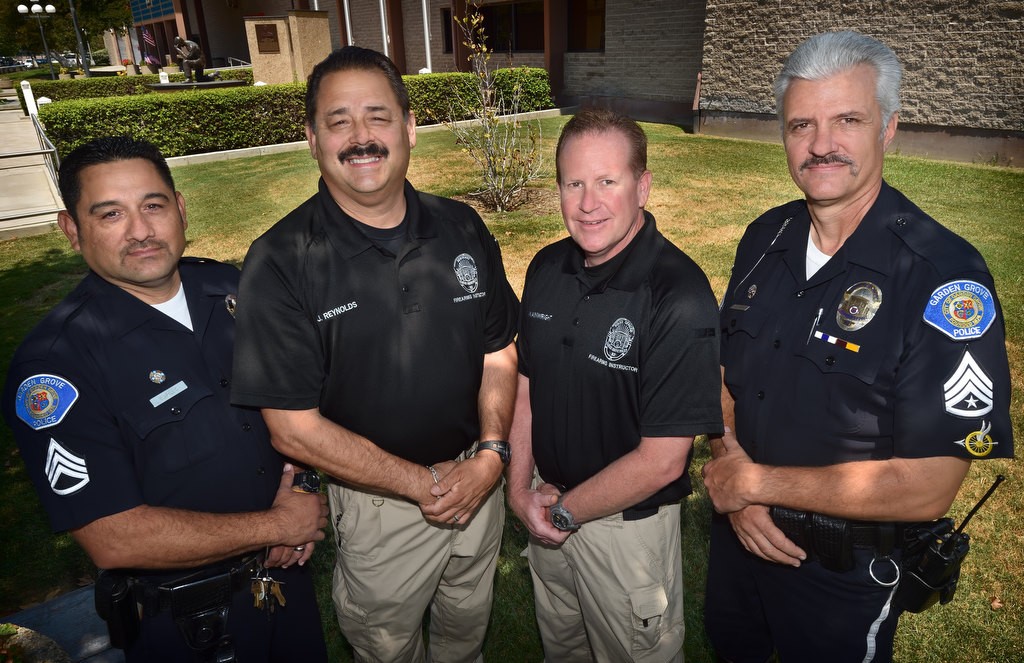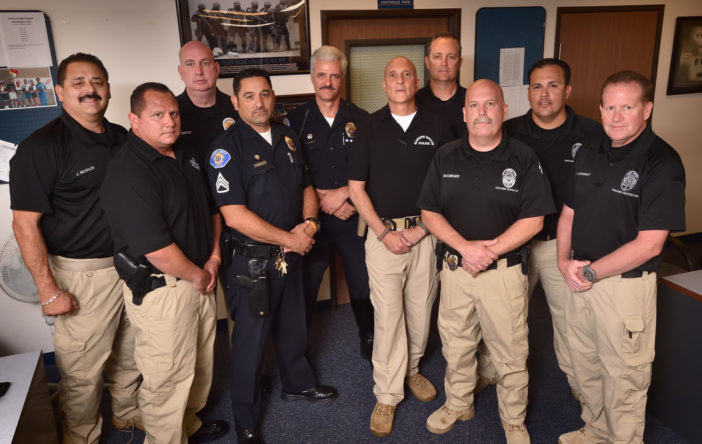Forward. Right. Forward. Back. Threat.
These commands will sound familiar to Garden Grove PD officers as part of a list of drills designed to teach all new hires when and how to fire a shotgun, handgun or rifle if necessary.
“We’re paying attention to everything: their movements, their trigger control, their reset,” says Range Staff supervisor Sgt. Jon Wainwright, referring to the four instructors onsite at the Westminster Police Department Range where new hire training of five officers took place on a recent Wednesday.
The officers underwent eight hours of classroom training and orientation before an eight-hour day of practice shooting.
At the end of the training, the new hires took a qualification test required of all armed employees. Qualifications occur quarterly for handguns and rifles and annually for shotguns, and all approximately 140 sworn GGPD employees are tested every quarter.
“We haven’t had anyone fail,” Wainwright says.
The teaching philosophy of the nine instructors who make up the GGPD Range Staff team is not about yelling. The instructors are closely watching the new hires for technique and safety, and are readily available to offer assistance.
“Calmly talk to them,” Wainwright says. “Show them what they’re doing wrong.”
The instructors come from various backgrounds, including homicide detectives, patrol sergeants and SWAT. In addition to experience with guns, the Range Staff team looks for good teachers.
“You’re looking for the guy who’s had a lot of street experience and weapons handling,” he says. “And most importantly, you’re looking for guys who can teach.”
Whether the new hires are just out of the academy or transfers from other agencies, the one-on-one training is equally hands-on.
More recently, the training has become less static and more movement-oriented, according to Wainwright. The reason is to keep up with world events. There has been an increase in the number of active-shooter incidents, such as the recent killings in Dallas. Officers must be able to move and shoot.

Garden Grove PD Range Masters Sgt. Rich Burillo, left, Sgt. John Reynolds, Sgt. Jon Wainwright and Sgt. Jim Fischer.
Photo by Steven Georges/Behind the Badge OC
Drills during the recent training involved officers facing left before shooting, turning right before shooting, turning completely around before shooting, shooting from a prone position, shooting four rounds in four seconds and a number of other combinations.
The concepts of threat (shoot) vs. challenge (the officer brings up his gun and orders a command but doesn’t shoot) also are important in the drills.
“It’s not just ‘shoot, shoot, shoot.’ We use challenge a lot,” he says. “It instills each officer to really focus on making the decision to shoot or not to shoot. We combine that with our use- of-force policy to minimize mistakes and to instill over and over that each scenario where they need to draw their weapons is not going to end with a shooting.”
For the fourth-quarter qualifications, the Range Staff holds a special session with SWAT for some active-shooter drills at an outdoor range, including drills such as shooting from inside and under police cars.
Transferred new hires — known as laterals — come from a variety of agencies and departments. Their backgrounds can impact how well they do during training. Different agencies will have different rules for technique and different makes and models of guns, which at first can be difficult for new employees to get used to, says Wainwright.
As the instructors monitor the officers, they watch each of them intently to fine-tune technique and form. For instance, how an officer pulls back the gun’s trigger can make a huge difference in accuracy. If it’s done too quickly and abruptly, the trigger will reset, causing excessive movement and a less precise shot.
Shooting from the hip is another area the instructors are stressing in light of the types of situations officers are being confronted with these days.
“A lot of the guys come from the academy and they’ve never been taught to shoot from the hip,” he says.
The importance of breathing also is covered, as well as the concept of owning every round fired.
“I have to explain why I fired that round,” Wainwright says.
Range Staff training isn’t limited to new hires. There is a portable range available to any employee who wishes to get in some practice at any time. All armed employees receive an allotment of ammunition for practice purposes.
Above all else, the Range Staff’s goal is safety.
“We don’t want to shoot anyone,” Wainwright says. “The goal is to go home and be safe.”
 Behind the Badge
Behind the Badge



